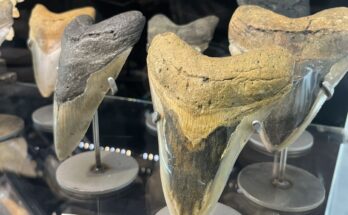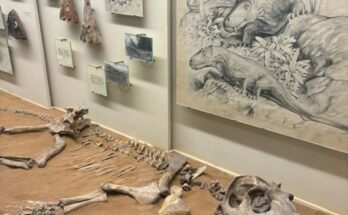Tyrannosaurus rex: A Comparative Analysis of Skull Morphology Across Growth Stages
Introduction to Tyrannosaurus rex Skull Evolution
The iconic Tyrannosaurus rex, one of the most formidable apex predators of the Late Cretaceous period (approximately 68–66 million years ago), continues to captivate scientists and the public alike through its extraordinary skeletal remains. The provided image presents a rare and instructive triptych of T. rex skulls at different ontogenetic (growth) stages, displayed in a laboratory setting. From left to right, we observe a massive adult skull cast, a subadult specimen, and a juvenile skull—each progressively smaller, yet sharing unmistakable tyrannosaurid traits. This visual comparison serves as an ideal educational tool for understanding cranial development, functional morphology, and biomechanical adaptations in one of paleontology’s most studied theropods. This detailed guide, structured like a professional paleontological tutorial, explores each specimen, interprets growth-related changes, and contextualizes their significance within T. rex biology and the broader field of dinosaur paleobiology.
The arrangement of the skulls—adult (largest), subadult (intermediate), and juvenile (smallest)—allows for direct observation of allometric growth patterns, where certain features scale disproportionately as the animal matures. Such displays are invaluable in research institutions, where casts and 3D-printed replicas enable non-destructive study of rare fossils.
Taxonomic and Temporal Context
Tyrannosaurus rex belongs to the following classification:
- Kingdom: Animalia
- Phylum: Chordata
- Class: Reptilia
- Clade: Saurischia
- Clade: Theropoda
- Family: †Tyrannosauridae
- Subfamily: †Tyrannosaurinae
- Genus: †Tyrannosaurus (Osborn, 1905)
- Species: †T. rex (Osborn, 1905)
Fossils are primarily recovered from the Hell Creek, Lance, and Scollard Formations of western North America, dating to the Maastrichtian stage of the Upper Cretaceous. T. rex reached sexual maturity around 14–16 years and could live up to 30 years, with maximum sizes attained in the late teens to early twenties.
Specimen Analysis: Ontogenetic Series
1. Adult Skull (Leftmost Specimen)
Approximate Length: ~1.5 meters (nearly 5 feet) Estimated Age: 18–25+ years Specimen Notes: This is a high-fidelity cast of a near-complete adult skull, likely modeled after famous specimens such as FMNH PR2081 (“Sue”) or MOR 555 (“Wankel Rex”). The skull is robust, with a broad, box-like nasal region and massive jaw musculature attachment sites.
Key Morphological Features:
- Deep, powerful skull with a short, wide rostrum—optimized for bone-crushing bite forces estimated at 35,000–57,000 Newtons (8,000–12,800 lbs), among the highest of any terrestrial animal.
- Heterodont dentition: Incisors are D-shaped in cross-section for gripping; maxillary teeth are thick, banana-shaped, and reinforced with thick enamel for puncturing and pulling.
- Large fenestrae (openings) reduced relative to skull size, increasing structural rigidity.
- Prominent sagittal crest formed by fused nasals, serving as anchor for powerful adductor muscles.
- Fused nasal bones with rough texture indicating keratinous covering in life (possibly a display structure).
- Orbit (eye socket) relatively reduced in proportion, reflecting decreased reliance on vision in favor of olfaction and bite force.
This skull represents the fully mature predatory phenotype—engineered for delivering devastating, bone-shattering bites to large herbivorous dinosaurs such as Triceratops and Edmontosaurus.
2. Subadult Skull (Center Specimen)
Approximate Length: ~1.0–1.1 meters Estimated Age: 11–15 years Specimen Notes: Likely a cast of a specimen such as BHI 6230 (“Stan”) in a mid-growth phase or a composite based on multiple subadult individuals (e.g., “Jane” or “Petey”).
Key Morphological Features:
- Gracile (slender) build compared to adult, with a longer, narrower snout.
- Larger orbits relative to skull length—suggesting enhanced visual acuity in younger individuals.
- Teeth more blade-like and less robust, with thinner enamel; suited for slicing flesh rather than crushing bone.
- Less pronounced muscle scars and a lower sagittal crest.
- More open skull structure with larger antorbital and temporal fenestrae, reducing weight during rapid growth.
This transitional morphology indicates a shift in ecological niche: subadults likely targeted smaller, more agile prey or scavenged, avoiding direct competition with dominant adults.
3. Juvenile Skull (Rightmost Specimen)
Approximate Length: ~0.6 meters (~2 feet) Estimated Age: 2–5 years Specimen Notes: Representative of specimens such as CMNH 7541 (“Cleveland Skull”) or LACM 23845 (“Baby Bob”), this skull is delicately built and shows early tyrannosaurid traits.
Key Morphological Features:
- Elongated, shallow snout resembling smaller theropods like Gorgosaurus or Dromaeosaurus.
- Very large orbits (proportionally enormous), indicating keen eyesight critical for a small predator.
- Serrated, recurved, laterally compressed teeth—ideal for slashing and tearing, not crushing.
- Lightweight construction with extensive fenestration and thin bone walls.
- Unfused sutures and smooth bone surfaces reflect ongoing rapid growth.
Juveniles occupied a drastically different ecological role—likely hunting small vertebrates (lizards, mammals, juvenile dinosaurs) and functioning as mesopredators within the ecosystem.
Growth Dynamics and Allometry
The ontogenetic series reveals positive allometry in several traits:
- Skull depth and width increase faster than length.
- Bite force potential scales with muscle cross-sectional area (proportional to skull robusticity).
- Orbit size decreases relative to skull length (negative allometry).
Studies using CT scans and finite element analysis (FEA) show that juvenile T. rex skulls could withstand only ~10–15% of adult bite forces, confirming dietary partitioning. This ontogenetic niche shift reduced intraspecific competition and allowed population stability.
Functional and Behavioral Implications
- Juveniles: Fast, agile hunters relying on speed and vision.
- Subadults: Transitional predators, possibly pack hunters, targeting mid-sized prey.
- Adults: Solitary apex predators delivering catastrophic bites to disable large herbivores.
Evidence from bone histology (growth rings) and isotope analysis supports rapid growth rates—up to 2 kg per day during teenage years—fueled by a high-protein diet.
Paleopathology and Individual Variation
Adult skulls often show healed injuries—fractured jaws, infected tooth sockets, and bite marks from conspecifics—indicating aggressive interactions. The adult in the image displays a healed lesion on the left maxilla, possibly from a failed bite or combat.
Laboratory and Educational Context
The lab setting (visible shelves, cabinets, and equipment) suggests this display is part of a research or museum prep facility. Such comparative mounts are used for:
- Training paleontology students in cranial anatomy.
- 3D scanning and biomechanical modeling.
- Public outreach and documentary filmmaking.
Conclusion: A Window into Deep Time
This triptych of Tyrannosaurus rex skulls is more than a static display—it is a dynamic narrative of growth, adaptation, and survival. By studying such ontogenetic series, paleontologists reconstruct not just the anatomy, but the life history of Earth’s most famous predator. For researchers, educators, and enthusiasts, this image serves as a perfect entry point into advanced topics like heterochrony, ecological modeling, and evolutionary developmental biology.
Pro Tip for Aspiring Paleontologists: When analyzing theropod skulls, always measure the following ratios:
- Snout Length / Skull Length
- Orbit Diameter / Skull Height
- Maxillary Tooth Row Length / Total Skull Length
These metrics quantify growth stages and enable comparisons across tyrannosaurid genera.
Explore institutions like the Field Museum, Black Hills Institute, or the Smithsonian to view similar specimens in person—and consider contributing to citizen science projects that digitize fossil data for global research.




